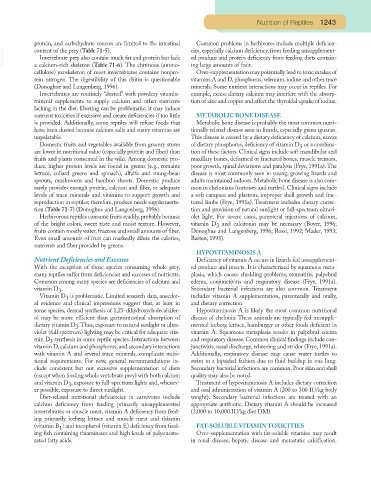Page 1193 - Small Animal Clinical Nutrition 5th Edition
P. 1193
Nutrition of Reptiles 1243
protein, and carbohydrate sources are limited to the intestinal Common problems in herbivores include multiple deficien-
VetBooks.ir content of the prey (Table 71-5). cies, especially calcium deficiency, from feeding unsupplement-
Invertebrate prey also contain much fat and protein but lack
ed produce and protein deficiency from feeding diets contain-
a calcium-rich skeleton (Table 71-6). The chitinous (amino-
ing large amounts of fruit.
cellulose) exoskeleton of most invertebrates contains nonpro- Over-supplementation may potentially lead to toxic intakes of
tein nitrogen. The digestibility of this chitin is questionable vitamins A and D, phosphorus, selenium, iodine and other trace
(Donoghue and Langenberg, 1996). minerals. Some nutrient interactions may occur in reptiles. For
Invertebrates are routinely “dusted” with powdery vitamin- example, excess dietary calcium may interfere with the absorp-
mineral supplements to supply calcium and other nutrients tion of zinc and copper and affect the thyroidal uptake of iodine.
lacking in the diet. Dusting can be problematic; it may induce
nutrient toxicities if excessive and create deficiencies if too little METABOLIC BONE DISEASE
is provided. Additionally, some reptiles will refuse foods that Metabolic bone disease is probably the most common nutri-
have been dusted because calcium salts and many vitamins are tionally related disease seen in lizards, especially green iguanas.
unpalatable. This disease is caused by a dietary deficiency of calcium, excess
Domestic fruits and vegetables available from grocery stores of dietary phosphorus, deficiency of vitamin D or a combina-
3
are lower in nutritional value (especially protein and fiber) than tion of these factors. Clinical signs include soft mandibular and
fruits and plants consumed in the wild. Among domestic pro- maxillary bones, deformed or fractured bones, muscle tremors,
duce, higher protein levels are found in greens (e.g., romaine poor growth, spinal deviations and paralysis (Frye, 1991a).The
lettuce, collard greens and spinach), alfalfa and mung-bean disease is most commonly seen in young, growing lizards and
sprouts, mushrooms and bamboo shoots. Domestic produce adults maintained indoors. Metabolic bone disease is also com-
rarely provides enough protein, calcium and fiber, or adequate mon in chelonians (tortoises and turtles). Clinical signs include
levels of trace minerals and vitamins to support growth and a soft carapace and plastron, improper shell growth and frac-
reproduction in reptiles; therefore, produce needs supplementa- tured limbs (Frye, 1991a). Treatment includes dietary correc-
tion (Table 71-7) (Donoghue and Langenberg, 1996). tion and provision of natural sunlight or full-spectrum ultravi-
Herbivorous reptiles consume fruits readily, probably because olet light. For severe cases, parenteral injections of calcium,
of the bright colors, sweet taste and moist texture. However, vitamin D and calcitonin may be necessary (Boyer, 1996;
3
fruits contain mostly water, fructose and small amounts of fiber. Donoghue and Langenberg, 1996; Rossi, 1992; Mader, 1993;
Even small amounts of fruit can markedly dilute the calories, Barten, 1995).
nutrients and fiber provided by greens.
HYPOVITAMINOSIS A
Nutrient Deficiencies and Excesses Deficiency of vitamin A occurs in lizards fed unsupplement-
With the exception of those species consuming whole prey, ed produce and insects. It is characterized by squamous meta-
many reptiles suffer from deficiencies and excesses of nutrients. plasia, which causes shedding problems, stomatitis, palpebral
Common among many species are deficiencies of calcium and edema, conjunctivitis and respiratory disease (Frye, 1991a).
vitamin D . Secondary bacterial infections are also common. Treatment
3
Vitamin D is problematic. Limited research data, anecdot- includes vitamin A supplementation, parenterally and orally,
3
al evidence and clinical impressions suggest that, at least in and dietary correction.
some species, dermal synthesis of 1,25-dihydroxycholecalcifer- Hypovitaminosis A is likely the most common nutritional
ol may be more efficient than gastrointestinal absorption of disease of chelonia. These animals are typically fed unsupple-
dietary vitamin D .Thus, exposure to natural sunlight or ultra- mented iceberg lettuce, hamburger or other foods deficient in
3
violet (full spectrum) lighting may be critical for adequate vita- vitamin A. Squamous metaplasia results in palpebral edema
min D synthesis in some reptile species. Interactions between and respiratory disease. Common clinical findings include con-
3
vitamin D, calcium and phosphorus, and secondary interactions junctivitis, nasal discharge, wheezing and stridor (Frye, 1991a).
with vitamin A and several trace minerals, complicate nutri- Additionally, respiratory disease may cause water turtles to
tional requirements. For now, general recommendations in- swim in a lopsided fashion due to fluid buildup in one lung.
clude consistent but not excessive supplementation of diets Secondary bacterial infections are common. Poor skin and shell
(except when feeding whole vertebrate prey) with both calcium quality may also be noted.
and vitamin D , exposure to full-spectrum lights and, whenev- Treatment of hypovitaminosis A includes dietary correction
3
er possible, exposure to direct sunlight. and oral administration of vitamin A (200 to 300 IU/kg body
Diet-related nutritional deficiencies in carnivores include weight). Secondary bacterial infections are treated with an
calcium deficiency from feeding primarily unsupplemented appropriate antibiotic. Dietary vitamin A should be increased
invertebrates or muscle meat, vitamin A deficiency from feed- (2,000 to 10,000 IU/kg diet DM).
ing primarily iceberg lettuce and muscle meat and thiamin
(vitamin B ) and tocopherol (vitamin E) deficiency from feed- FAT-SOLUBLE VITAMIN TOXICITIES
1
ing fish containing thiaminases and high levels of polyunsatu- Over-supplementation with fat-soluble vitamins may result
rated fatty acids. in renal disease, hepatic disease and metastatic calcification.

